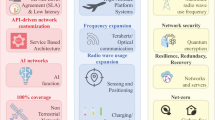Abstract
Today’s 4G and 4.5G network is not capable of meeting the needs of a broadband network, 5G is designed to meet the needs. The key features of 5G include high throughput, improved spectrum efficiency, and reduced latency. Higher frequencies may be used by 5G, but the result is high cost. Furthermore, the volumes of video traffic in wireless system networks, there is an urgent need for improving the quality of video delivery. For this reason, this paper is devoted to proposing a wireless mobile system based on the updated LTE-ADV Pro (4.5G–4.9G) technology to arrive 5G capability with low cost. The proposed system uses advanced adaptive modulation and coding and advanced waveform to provide higher spectral efficiency. It also incorporates the proposed method of the adaptive video streaming of multiple video data rates. The results presented that the proposed wireless technique is better than LTE-ADV regarding data transmitted, while the proposed video coding method is better than H.265. The overall result in the proposed system is supported users about is 24% as compared to LTE-ADV with H.265 and about is 100% as compared to LTE with H.265.











Similar content being viewed by others
References
Dao N, Park M, Kim J, Cho S (2017) Adaptive MCS selection and resource planning for energy-efficient communication in LTE-M based IoT sensing platform. PLoS One 12(2):1–20
Virrankoski R (2011) LTE-advanced: technology and performance analysis. University of Vaasa, Vaasa
Erik Dahlman SP, Sköld J (2011) 4G LTE/LTE-advanced for Mobile broadband. Elsevier Ltd., London
Galih R (2016) Carrier aggregation technique to improve capacity in LTE-advanced network. TELKOMNIKA 14(1):119–128
Hämälainen J (2013) The future of LTE: the femtocells perspective
Hanzaz Z, Schotten HD (2013) Analysis of effective SINR mapping models for MIMO OFDM in LTE system. In: 2013 9th international wireless communications and Mobile computing conference (IWCMC), pp 1509–1515
Huu TN, Trieu DD, Jeon B, Hoangvan X (2017) Performance evaluation of frame-loss error-concealment solutions for the SHVC standard. IEIE Trans Smart Process Comput 6(6):428–436
Ibrahim SK, Khamiss NN (2019) Optimal usage of LTE advanced system to support multi-user in video streaming application. In: 2018 third scientific conference of electrical engineering (SCEE), pp 197–202
Ibrahim SK, Khamiss NN (2019) Improved video coding technique for next generation communication system. J Commun 14(8):715–720
Ibrahim SK, Khamiss NN (2019) A new wireless generation technology for video streaming. J Comput Networks Commun 2019:1–9
Jassal A, Member IS, Leung C, Member I (2016) H . 265 video capacity over beyond-4G networks. In: Communication QoS, Reliability andModeling Symposium IEEE ICC 2016, pp 1–6
Milicevic Z, Bojkovic Z (2014) HEVC vs. H.264/AVC through performance and complexity comparison. In: Applications of Computer Engineering (ACE’14), pp 58–61
Mohankumar NM, Devaraju JT (2013) Performance evaluation of round Robin and Proportional fair scheduling algorithms for constant bit rate traffic in LTE. IJCNWC 3:41–45
Nardini G, Stea G, Virdis A, Sabella D, Caretti M (2016) Broadcasting in LTE-advanced networks using multihop D2D communications. In: PIMRC 2016 no. 1, pp 1–6
Nightingale J, Wang Q, Grecos C (2012) HEVStream: a framework for streaming and evaluation of high efficiency video coding (HEVC) content in loss-prone networks. IEEE Trans Consum Electron 58:404–412
Ranjana R, Mahesh DK (2016) Video compression using compact tool ( HEVC ). Int J Adv Res Comput Sci Softw Eng 6(7):140–143
Sihag K, Lamba CS (2016) Algorithm and architecture Design of High Efficiency Video Coding ( HEVC ) standard. Int J Comput Sci Mob Comput 5(10):171–178
Soni G, Verma C (2015) Performance investigation of LTE systems based on NI PXIe-5644R vector signal transceiver. Glob. Conf. Commun. Technol. 2015, no. Gcct, pp 755–760
Sullivan GJ, Ohm JR, Han WJ, Wiegand T (2012) Overview of the high efficiency video coding (HEVC) standard. IEEE Trans Circuits Syst Video Technol 22(12):1649–1668
Tchao ET, Gadze JD, Agyapong JO (2018) Performance evaluation of a deployed 4G LTE network. Int J Comput Sci Mob Comput 9(3):165–178
Trivedi RD, Patel MC (2014) Comparison of different scheduling algorithm for LTE. Int J Emerging Technol Adv Eng 4(5):334–339
Uhrina M, Frnda J, Sevcik L, Vaculik M (2014) Impact of H . 264 / AVC and H . 265 / HEVC compression standards on the video quality for 4K resolution. Adv Electr Electron Eng J 12:368–376
Winken M, Helle P, Marpe D (2011) Transform coding in the HEVC test MODEL. In: IEEE international conference on image processing, pp 3693–3696.
Yonis AZ, Abdullah MFL, Ghanim MF (2012) LTE-FDD and LTE-TDD for cellular communications. In: Electromagnetics research symposium proceedings, pp 1467–1471
Zeng K, Rehman A, Wang J, Wang Z (2013) From H.264 to HEVC: coding gain predicted by objective video quality assessment models. In: Int. Work. Video process. Qual. Metrics Consum. Electron. (VPQM2013), pp 1–6
Zhang R, Zheng Z, Wang M, Shen X, Xie LL (2014) Equivalent capacity in carrier aggregation-based LTE-A systems: a probabilistic analysis. IEEE Trans Wirel Commun 13(11):6444–6460
Author information
Authors and Affiliations
Corresponding author
Additional information
Publisher’s note
Springer Nature remains neutral with regard to jurisdictional claims in published maps and institutional affiliations.
Rights and permissions
About this article
Cite this article
Ibrahim, S., Khamiss, N. Proposed of the wireless mobile system and video coding system in the heterogeneous network. Multimed Tools Appl 78, 34193–34205 (2019). https://doi.org/10.1007/s11042-019-08230-8
Received:
Revised:
Accepted:
Published:
Issue Date:
DOI: https://doi.org/10.1007/s11042-019-08230-8




